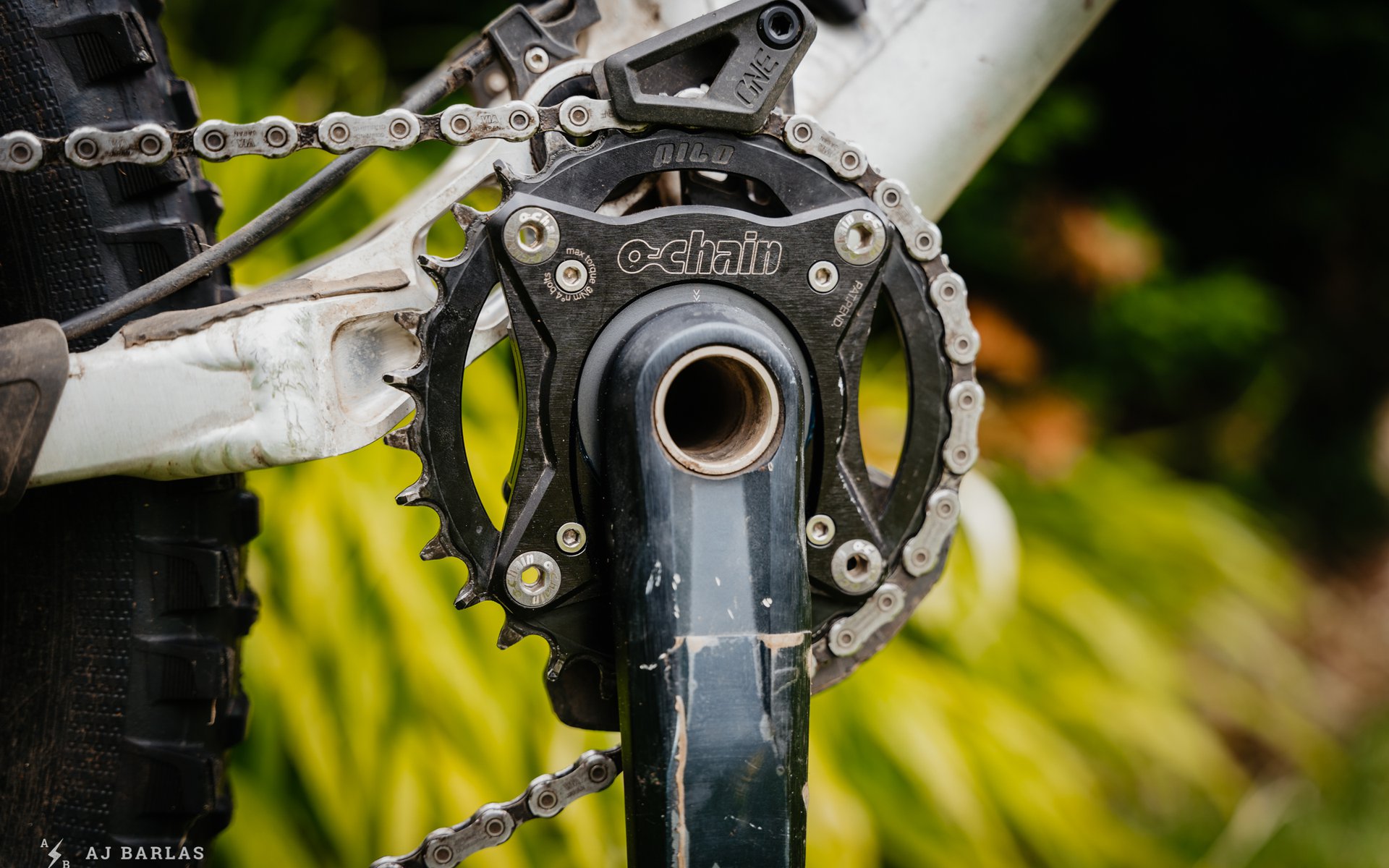
Weird But Wonderful
OChain Active Spider Review
The effect your chain has on our suspension, as well as how much feedback is transferred to our feet, have been hot topics recently. Steve at Vorsprung made a video about 'pedal kickback' a while ago that is well worth watching as it gives the best explanation of what’s happening. Others have written about pedal kickback but many fail to discuss the points Steve tackles, which are vital to understanding what’s happening and how the OChain can help improve things.
Fabrizio Dragoni felt the effects of the chain on his suspension were significant enough to create a product designed to reduce them. The OChain Active Spider has been subject to much skepticism, but there’s no denying that riding a bike chainless can improve suspension performance and feel; the bike remains calmer, is smoother, and grip improves. Aaron Gwin and Neko Mullaly have each posted incredible race runs after their chains were lost and many believe the improved suspension performance without a chain flapping around helped their performances.
A downside of riding chainless, that has taken some time for me to adjust for, is how freely my feet move. Feeling the light movement of the cranks without a chain when encountering holes or off jumps is unnerving at first. Once I get comfortable and stop trying to pedal out of corners, it's far more enjoyable.
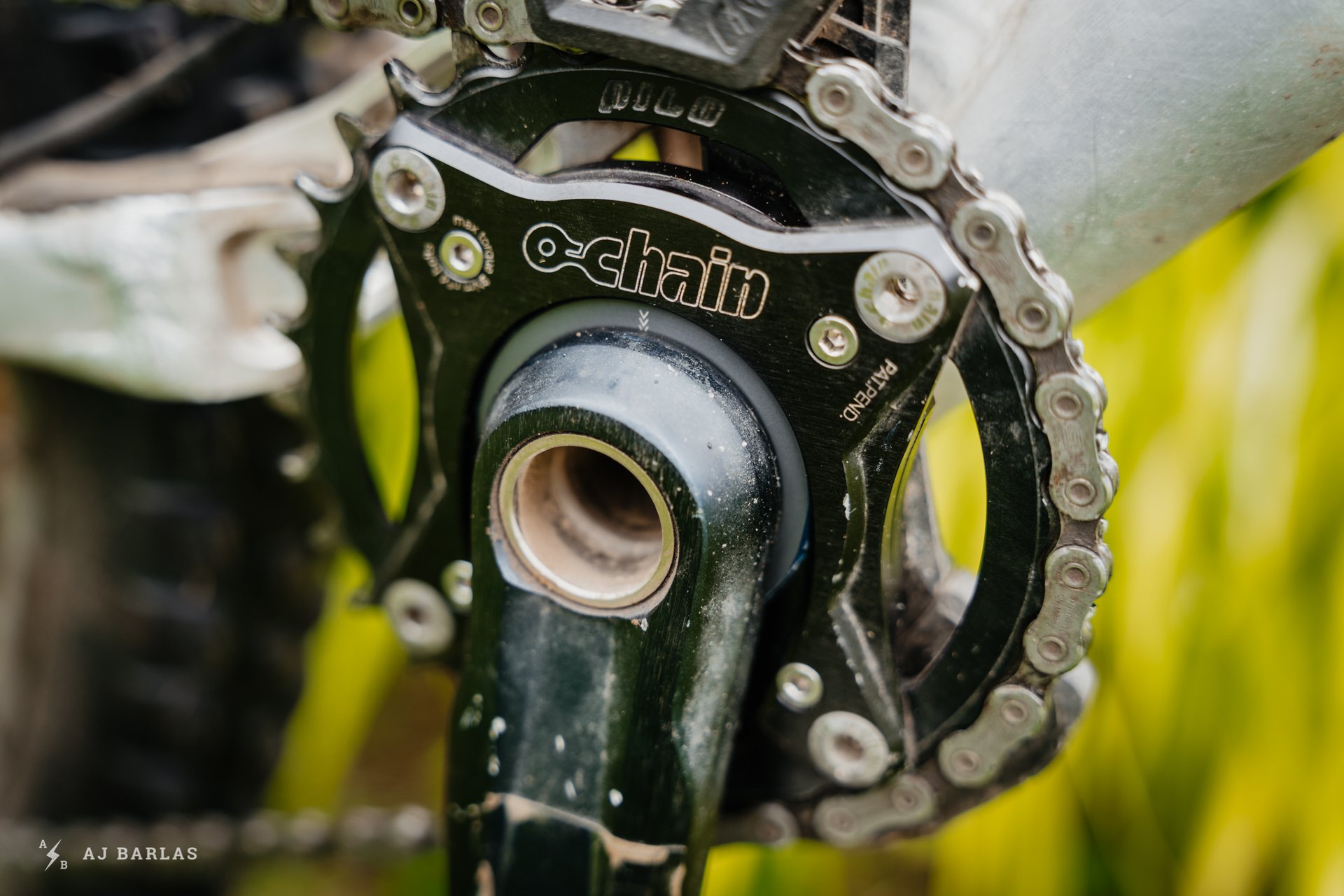
The OChain Active Spider consists of two parts that can rotate opposite each other, minimizing the effects of the chain tugging on the chainring.
What Does OChain Do?
OChain claims their Active Spider provides at least some of the benefits of removing the chain altogether. While riding bike park laps without a chain is possible (despite still requiring some 'skating') it's out of the question for trail riding. And you wouldn't dare race a World Cup without a chain; unless it breaks out of the start hut, as it did for Aaron Gwin. Many World Cup Downhill racers have used the OChain device now, including the current World Champion, Reece Wilson, who had it on when he won last year in Leogang. Looking at the coverage from the weekend in Leogang, OChain’s use at the World Cup level appears to be growing. Troy Brosnan is a notable racer using the spider, racing it to another victory at the first World Cup DH of 2021.
A couple of the scenarios that can affect the chain. Notable are the bounce tests where the OChain Active Spider can isolate some of the impact from the chain on the pedals and cranks.
The OChain spider allows the chain to rotate backwards a small amount, effectively isolating the chain’s movement from the feet as the rear wheel is compressed and extended repeatedly. Many dual-suspension mountain bikes have a rearward portion to the wheel's axle path, usually in the early part of wheel travel, which lengthens the chain in response to an impact. Our derailleurs allow for chain growth, which explains why single speed setups won't work without a tensioner or derailleur on dual-suspension bikes, but there are also forces pulling at the top of the chainring that the derailleur doesn’t counteract. This only partly explains why the bike feels different when the chain is removed because there's something else going on.
The chain bouncing up and down as the wheel encounters impacts also changes how the bike feels. How greatly this affects the bike will depend on the suspension kinematics to a degree but also the length of the chain, the gap between chain and stay, and also the terrain. To counteract the chain's effects on the chainring/cranks and suspension, OChain's Active Spider rotates backwards a set amount. Provided elastomers of three sizes allow either 4, 6, or 9 degrees of backward rotation, with an option to purchase a 12-degree setup as well.* With many different suspension designs and riding styles on the trails, OChain provides the four sizes to allow users to customize the feel.
*OChain originally released the Active Spider with 6, 9, and 12-degree setups but has since updated it to the settings above.
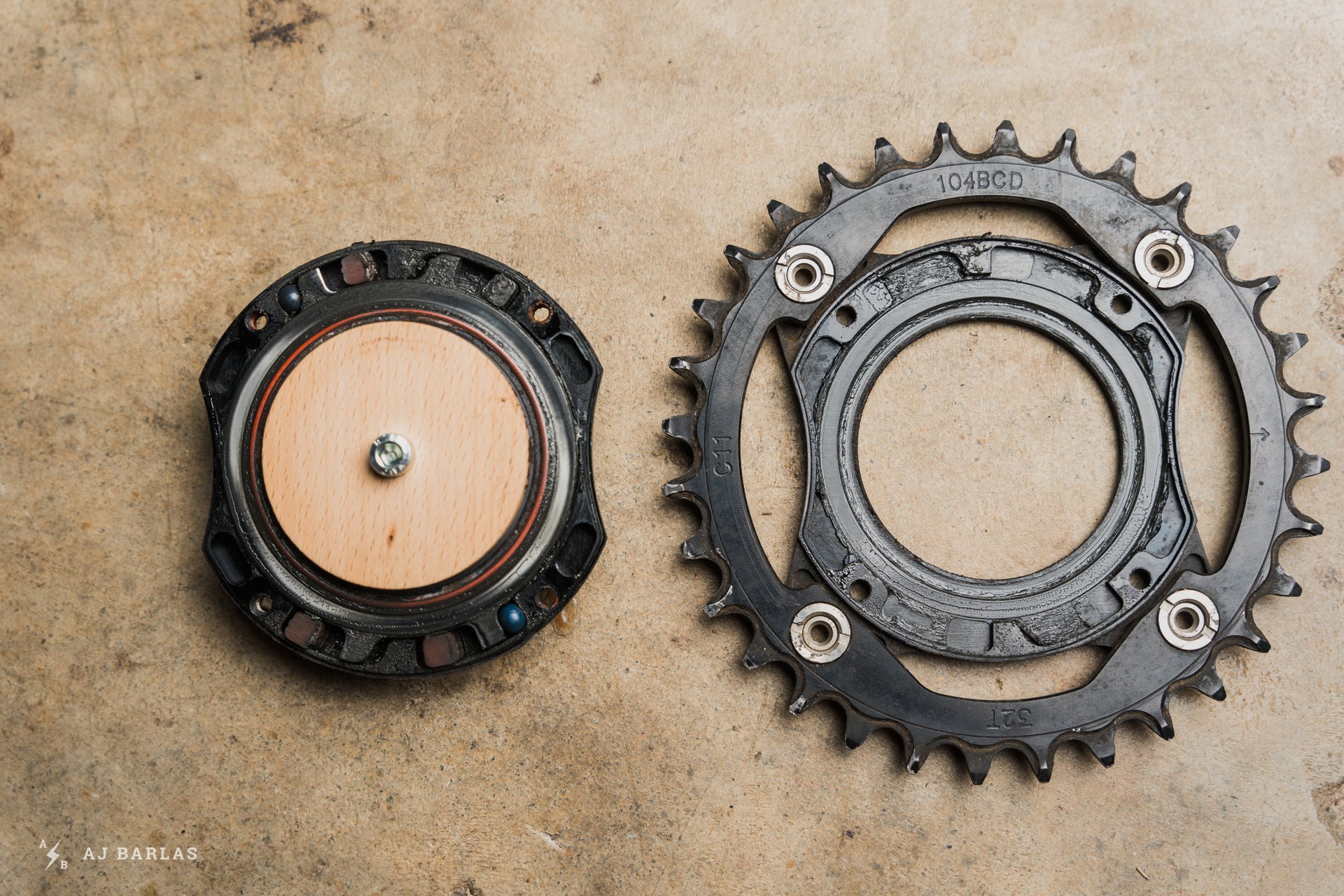
The adjustable innards of the OChain device. The wood pieces, bolt and wingnut are helpful to keep the inner springs and working components together while changing elastomers. Without them, things can quickly get messy.
Setup & Riding
My OChain arrived with the 6-degree elastomers installed. Mounting relies on a direct mount chainring setup – SRAM, Shimano, e*thirteen, Hope, Cane Creek and Race Face – and a chainring with a 104 BCD. Removing the old chainring from my Shimano SLX cranks was straightforward and the OChain slotted into place easily. Sitting on the bike immediately felt strange, with the extra movement creating a slight delay before the chain engaged the pawls in the rear hub.
For the duration of testing, the OChain was paired with a Hunt rear hub that features 3 degrees of engagement. I've not typically found myself lusting for the highest engaging rear hubs, but the benefits are noticeable for at least the first ride or two. The same can be said for the effects of the OChain. After the first ride, I was hunting technical climbing scenarios to see if it hindered me and cannot say it had a noticeable effect.
It's also worth mentioning that the duration of testing – just shy of 1,000km of trail time since mid-December – was spent on flat pedals. OChain informs me that clipped-in riders also benefit from the active spider – refer to the World Cup DH bikes for reference – but flat pedal riders can benefit more from the device. This is thanks to flat pedal riders needing to load the bike differently than clip riders, who can ride lighter on the pedals, particularly in rough sections of trail. I also used an STFU for most testing, which also limits the amount of chain movement, further improving ride quality.
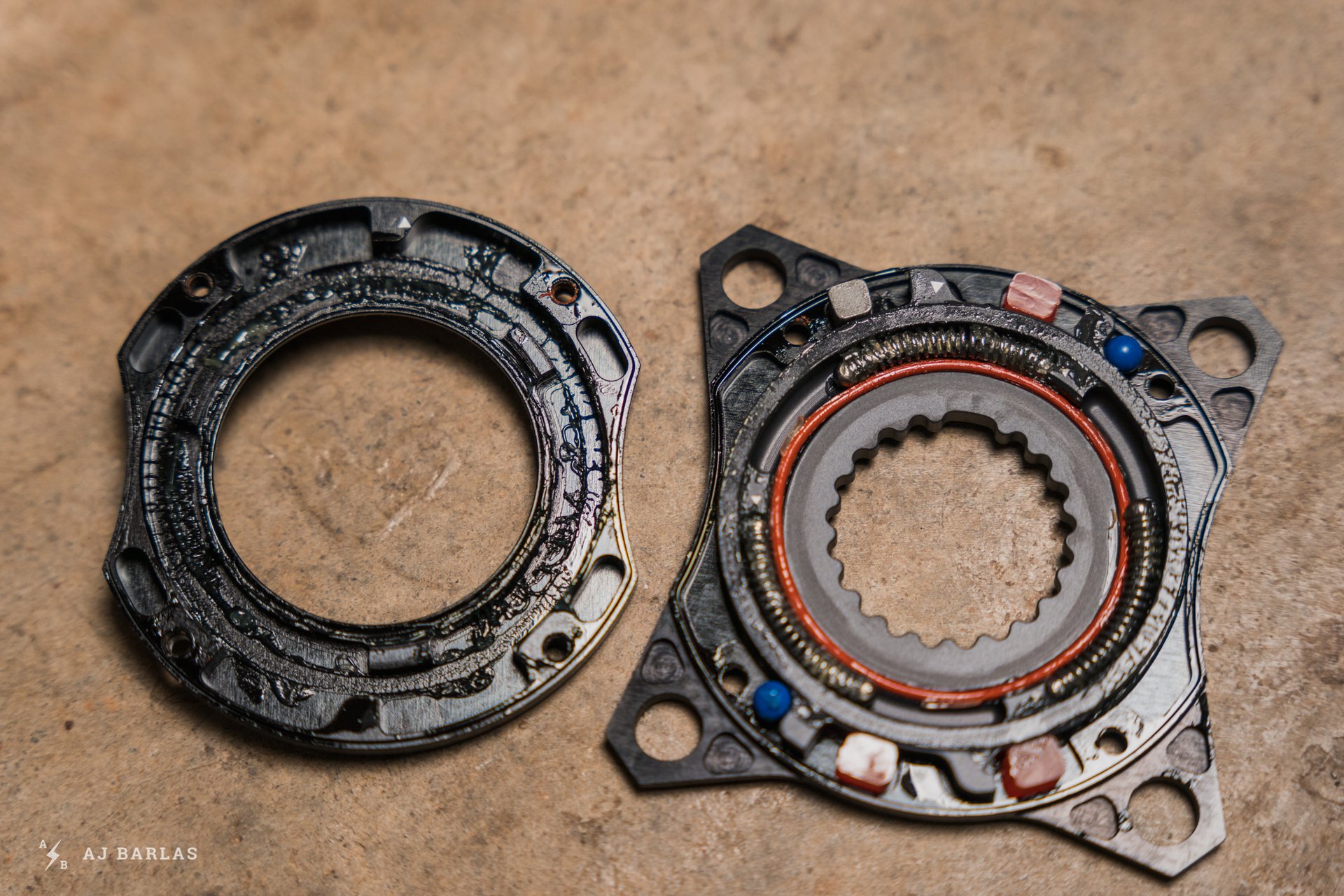
The OChain works with two spring loaded counter-rotating plates. The movement is limited by the orange elastomers and for all but the 12-degree setup, a small metal piece to prevent the elastomers getting completely mashed.
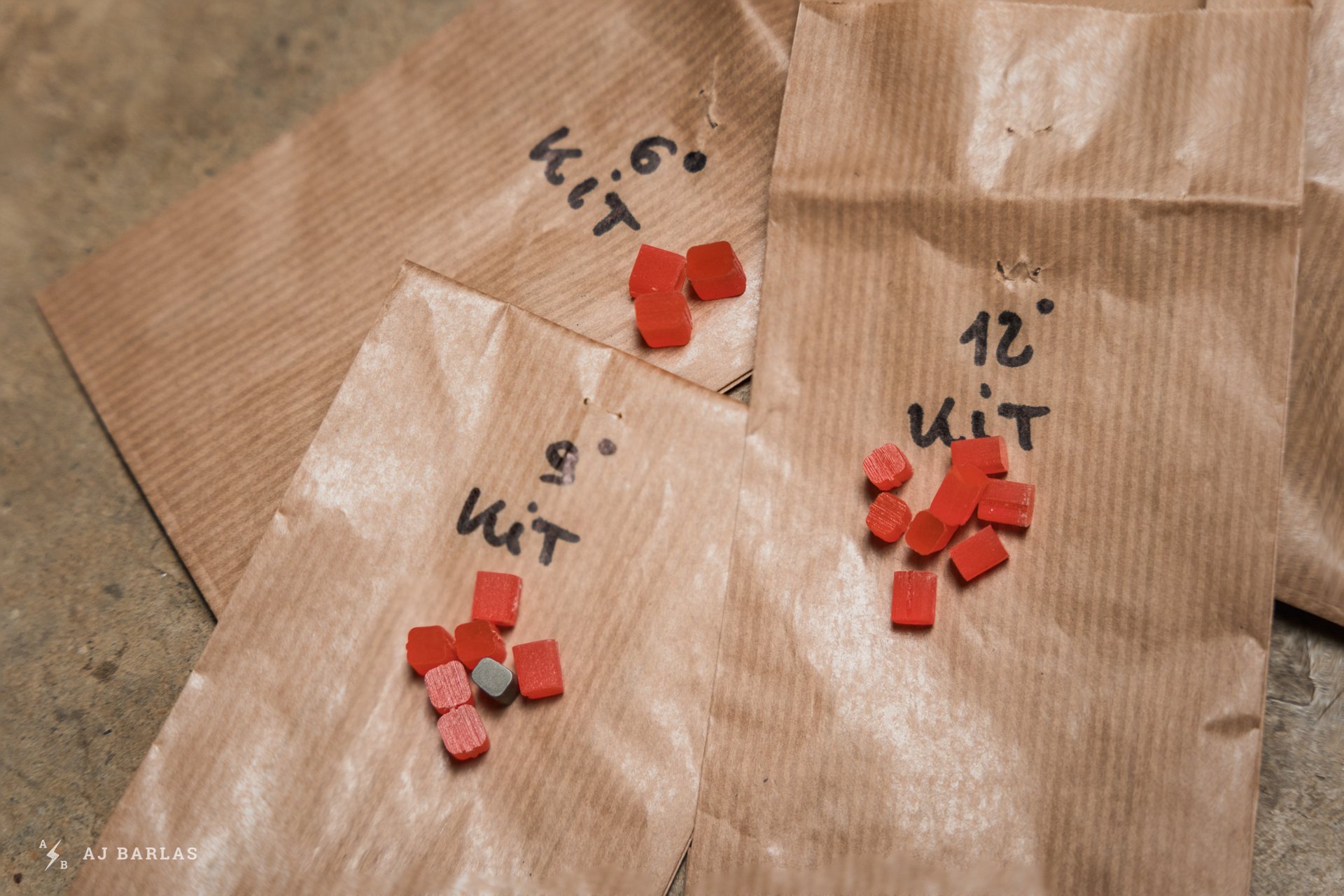
Originally the OChain was packaged with 6, 9, and 12-degree elastomers
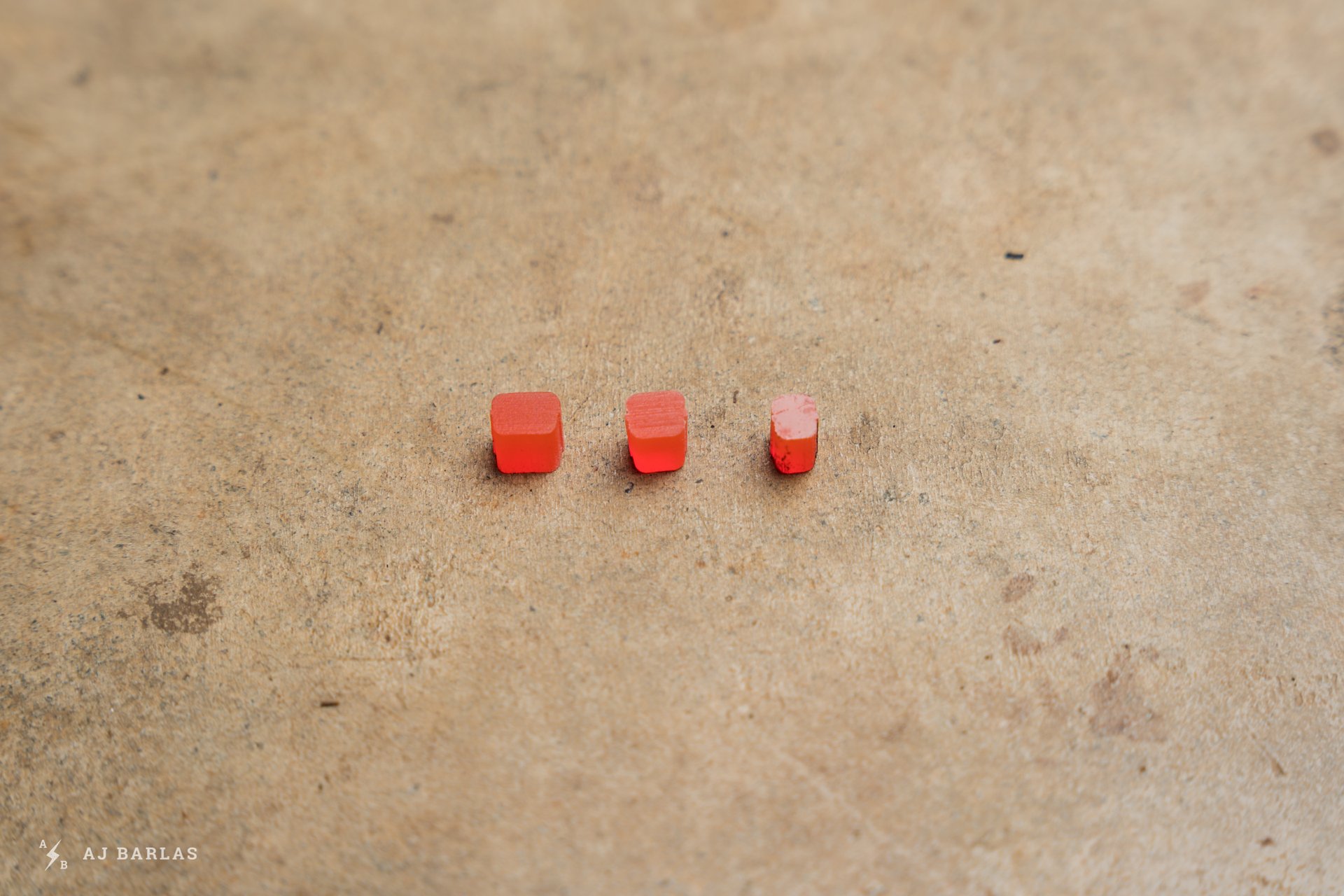
The difference between the 6, 9, and 12-degree elastomers is small, but noticeable on the trail.
With the OChain installed, which was relatively easy to do, I headed for the trails. The inaugural ride began with a few loops of some newer jump trails in Squamish – Miki's Magic and Slippery Salmon. There wasn't much notable on these trails and I chalked anything I felt up to a placebo effect. But moving from there into the tech chunk in the Alice Lake network opened my eyes.
In terrain with more feedback, the benefits of the OChain are clear. I'm still cautious about claiming climbing produces anything more than excessive focus on what's happening, but descending is another story. It feels amazing across chatter and through medium-size hits, isolating much of the feedback I usually feel at my pedals. Sudden square-edged obstacles still produced a very noticeable thud at my feet in some situations with the 6-degree setting. The quieter feeling in most situations amplified this, catching me off-guard, but it also highlighted that a higher degree of rotation in the OChain could be warranted.
Through transitions where we use our feet to force chain tension, pumping momentum from the terrain, the minimized feedback left the bike feeling a bit vague. I stopped and hit some sections like this repeatedly early in testing, adjusting how I rode them. The OChain allowed me to float across these chattery sections. Where I'd normally be braced for impacts and preparing to pump the terrain, I found myself out of the section quickly and riding lighter as the bike seemed to hover across the ground.
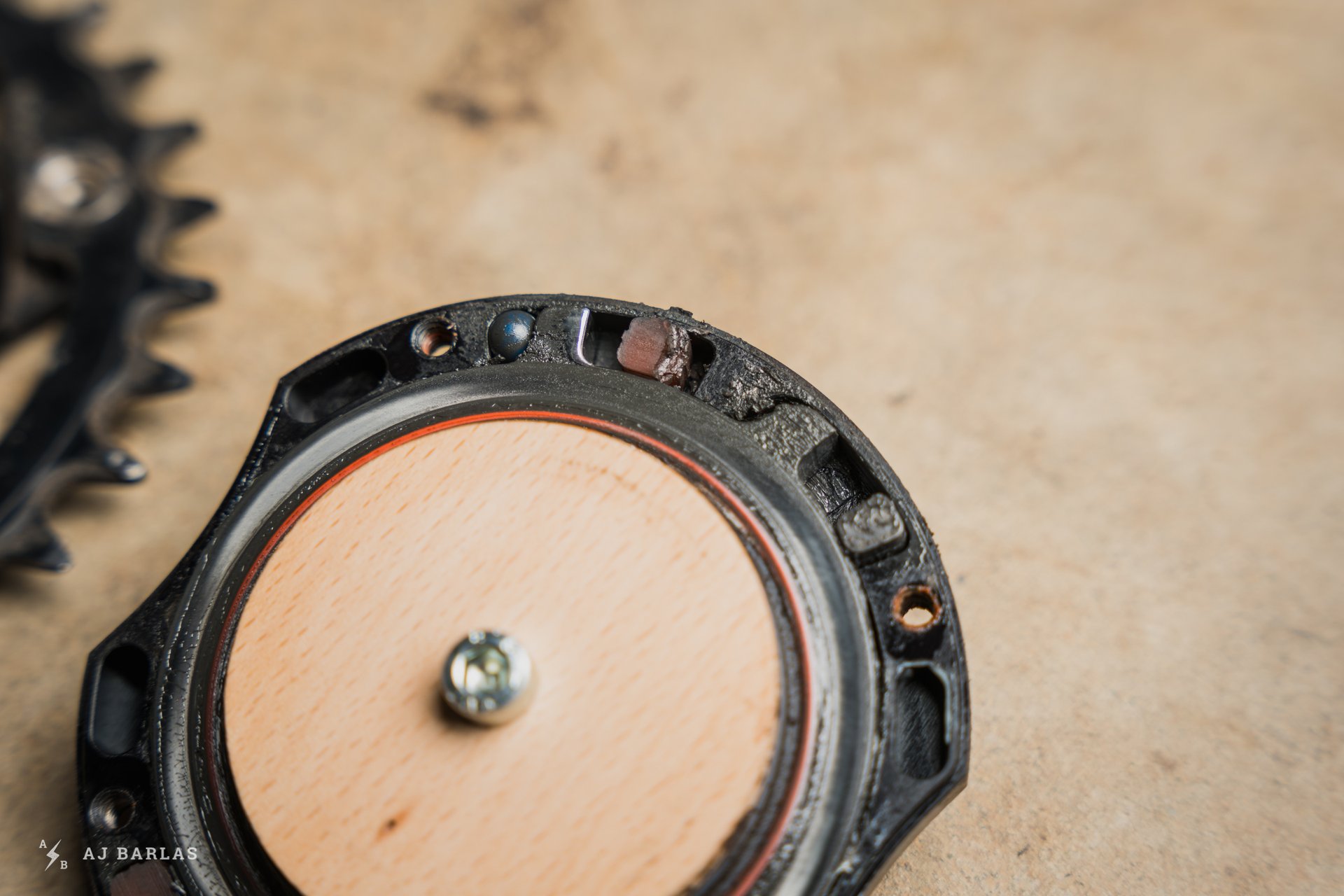
My 9-degree elastomers show some signs of wear after close to 400km of use but they still have plenty of life left.
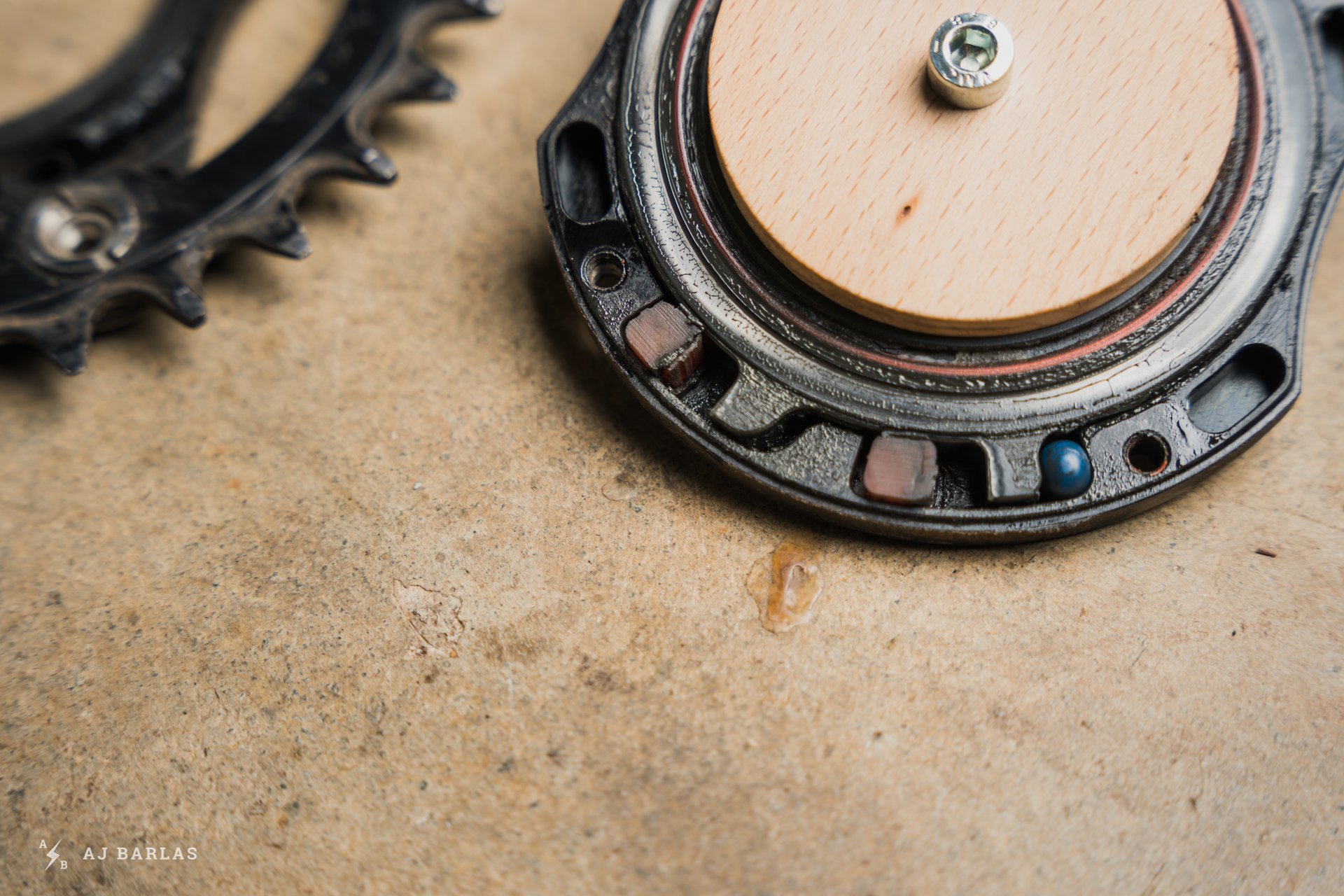
The blue balls are to limit the extension of the device while the elastomers limit compression.
As rides progressed, I adjusted my technique to work with the changes the OChain had on the bike and found myself able to ride with greater comfort. The bike tracks better with the OChain, and going back-to-back is a stark reminder of the chain's impact on suspension performance and comfort. I did find that on the trails I frequent with the G1, the 6-degree setting continued to tug at my feet when encountering quick square edges of a few inches in size. I eventually swapped for the 9-degree elastomers to see if things would improve.
With work, life and winter stalling the swap, it was a while before I got around to making the change. In that time, the OChain saw roughly 650km of trail use. The extra time spent on the 6-degree elastomers wore on them, smashing away the leading edge. I reached out to OChain about this and was informed that it's mostly from the pedalling forces, which engage the inners against the elastomers and the appropriate metal spacer under a more constant load. I didn't hear any of the metal clangs from the spider that Fabrizio informed me happens once the elastomers are toast – said to be after roughly 50,000m of climbing – so I still have life in them despite their appearance. I cleaned everything up, installed the thinner 9-degree pieces and all was good.
For my bike and riding, the 9-degree option is great and I'm happy to stick with it. The unexpected spike of feedback in my feet when encountering square edges with the 6-degree setting was drastically reduced with this setup. Fabrizio has removed the 12-degree elastomers from the stock kit and is now recommending it specifically for downhill bikes. Pedalling on the 12-degree setup feels squishy, with no metal spacer to help provide a solid endpoint and the small spacers do little. I was informed that trail riding with these would result in them needing replacing often and it’s not recommended. If I still owned a downhill bike I’d likely install the 12-degree OChain setup. Once I get up to the bike park I’ll do a bit more testing on the 12-degree elastomers but I won’t go back to it since most of my riding is self-powered.
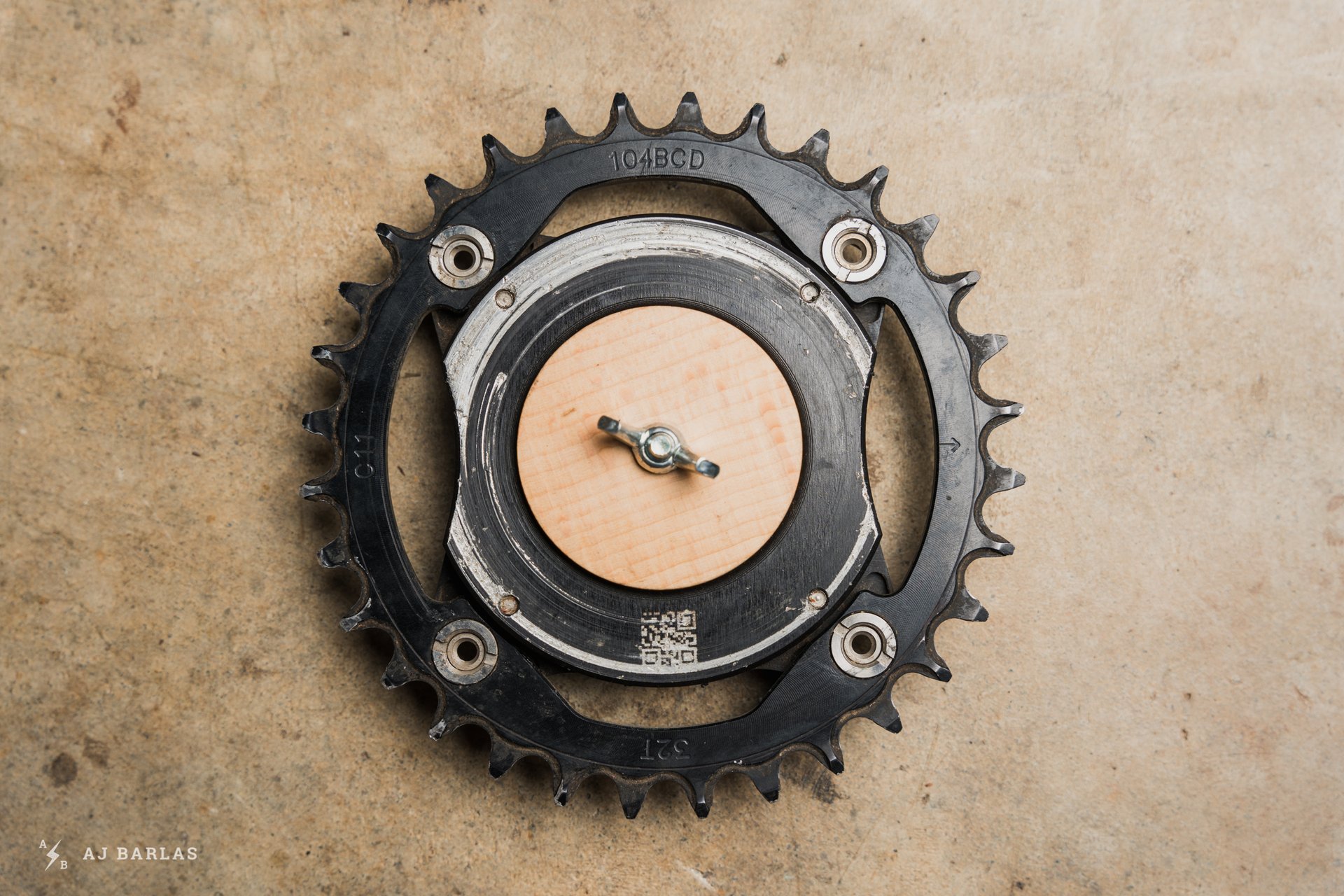
Chainring wear is minimal relative to the use and conditions the alloy ring has seen. But I certainly had some wear on the spider's housing.
Unexpected Benefits
The amount the OChain improved my rides has been surprising and although I thought the delayed pedal response would be a problem, it hasn't been. But what caught me by surprise most was the improvement in chainring wear. Riding left foot forward, the front-most edge and around the bottom of the chainring exhibits wear, but it’s much less than I had with my previous chainring. It also took much longer for any sign of wear to show up. Across the top of the ring where I usually see an equal amount of wear, it's minimal.
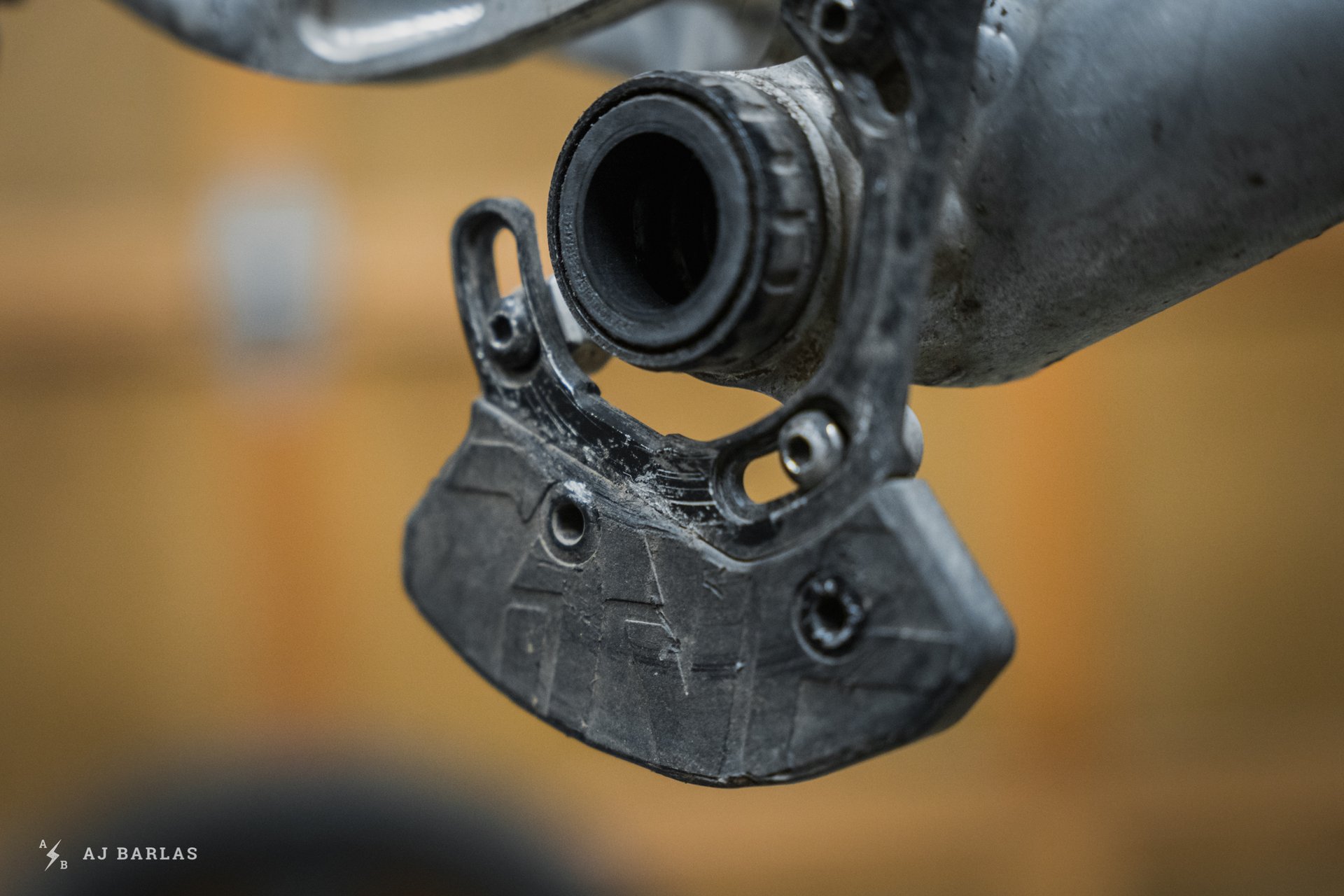
There's usually a small clip on the OneUp Bash Guide but with trail grit catching between this and the spider, it blew off. Since it's been gone, there have been no problems with clearance, regardless of conditions.
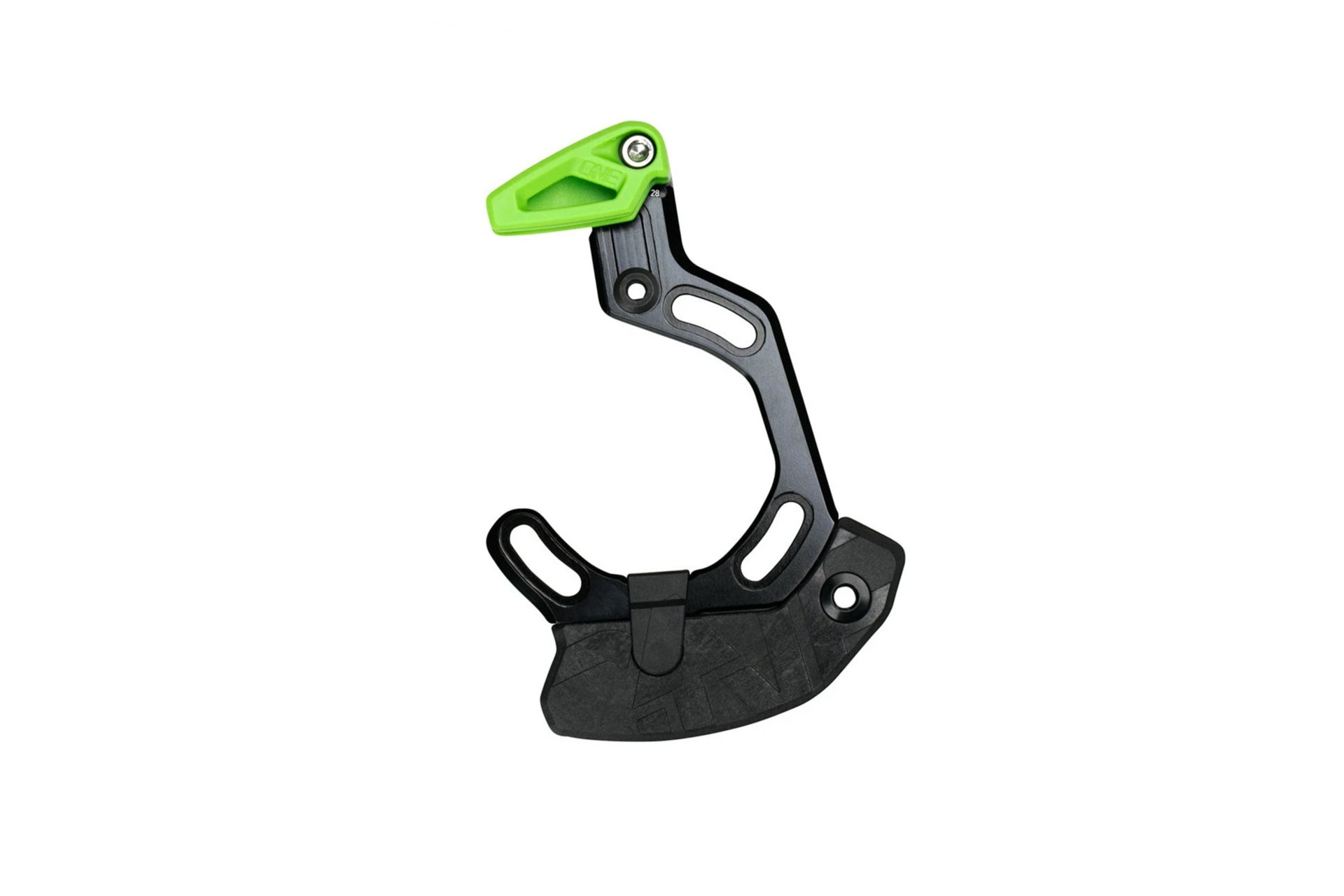
A look at a OneUp Bash Guide with the clip that wore off my guide. My guide still functions perfectly without it but it is something for riders to be aware of. I had no room to move without making a horrible chainline if this didn't break off. Photo: OneUp Components
Possible Drawbacks
There is potential for chainline and clearance to be a problem on some bikes. With the OChain fitted, it was tight between my chainguide and the spider’s backing, thanks to the thicker body of the spider housing the parts that make it work. Thinking I had just enough space, I hit the trails but found in sloppy winter conditions the grit got caught between the parts, causing the spider to rub the chainguide, particularly a clip on the OneUp Bash Guide. The clip isn’t needed for the guide to function and once it was removed the bike ran smoothly and quietly, regardless of the conditions.
The delay in power to the rear wheel will be a deal-breaker for some riders but the improved performance and comfort when descending may be enough to sway others. Switching to a lower engaging rear hub – a DT 240s with 36t star ratchet providing an engagement of 10 degrees – I can’t say the difference was noticeable. There’s a bit more delay before pickup but nothing clearly noticed otherwise. I'll be performing a back-to-back test in the Whistler Bike Park with the high vs low engaging wheels soon to better report on the effects they have on the trail. At that time I'll also perform back-to-back tests from no OChain with a low engaging hub to a high engaging hub with the OChain, to better discuss the differences between each.
Finally, the OChain is a performance part that results in increased maintenance and cost. Despite having no idea how to perform a service, a complete clean and re-grease took 30 minutes max, following OChain’s guide. After 1,000km on the spider, it was pretty grimy inside but there was no noticeable effect on performance.
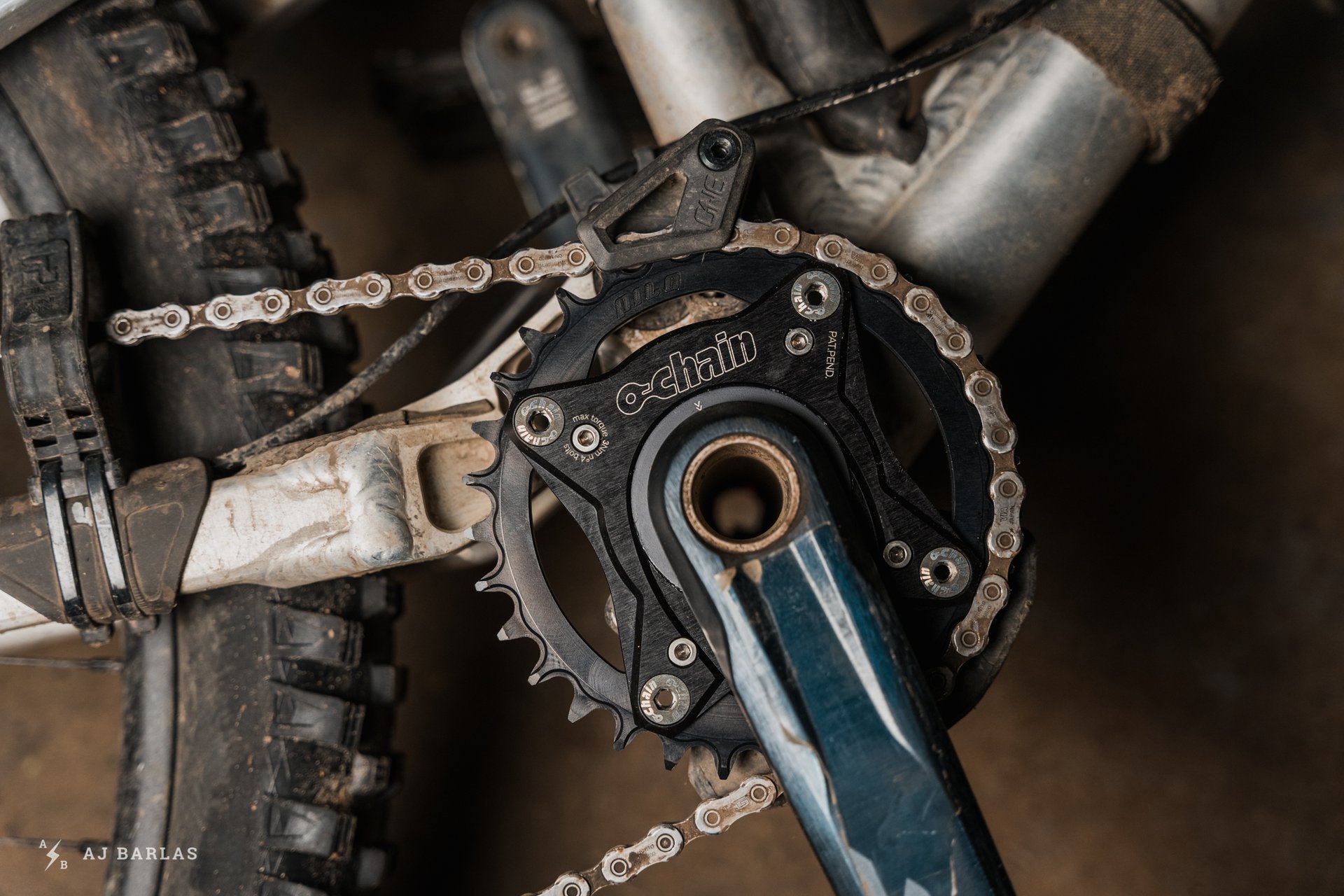
Not for everyone but I've found it a great addition to my bike.
Conclusions
The OChain is a great addition for riders after improved suspension performance and comfort. In the last 18 months, it stands out as the product with the most resounding impact on my riding enjoyment and now I dread riding without one. As long as a device like OChain is around, there will be one on my bike. Going out on a limb, it's one of the most beneficial suspension upgrades available, and it’s not a suspension part.
It won't, however, be for everyone. Riders who absolutely must have the tightest transmission won't be happy with the delay it can introduce. I haven't found it to cause an issue on any of the technical climbs in Squamish and I struggle with the same climbs while making the ones I was able to before. Riders that prioritize comfort, grip and suspension performance over everything else will enjoy the benefits OChain provides.
More on the OChain Active Spider.
Age: 39
Height: 191cm/6’3"
Weight: 73kg/160lbs
Ape Index: 1.037
Inseam: 32”
Trail on Repeat: Changes as often as my mood.
Current Regular: Every test product spends time on Entrail

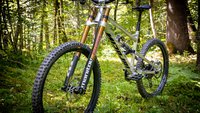
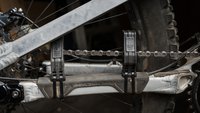
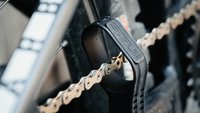



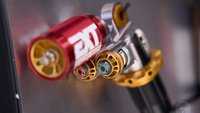



Comments
Ryan Walters
2 years, 10 months ago
Mountain bikers are hilarious. *Runs instant engagement hub, adds O-chain device. lol
Reply
Alex D
2 years, 10 months ago
Indeed. I'd be interested in a comparison between this and a DT hub with an 18T ratchet.
Reply
Ryan Walters
2 years, 10 months ago
This is exactly what I run for the express purpose of reduced interaction between suspension and drivetrain. No O-chain required.
Reply
Jerry Willows
2 years, 10 months ago
also less drag...
Reply
Ryan Walters
2 years, 10 months ago
Also stronger ratchet.
Reply
Cam McRae
2 years, 10 months ago
How do you counteract or adjust for the aforementioned randomness? There is no way of knowing if you are close to the next engagement point or as far away as you can be, which is an element I have absent-mindedly recognized but never thought about enough. Your 15º hub could be all of that number or almost zero and everywhere in between, and this occurrence should be entirely random. Although at high speed as the chain winds up, as noted in Steve's video referenced in the article, you are more likely to be closer to the highest engagement point. I think.
Oddly, I regularly swap between wheels or bikes with vastly different engagement points and I have not been aware of any difference at all, either descending or climbing in technical situations. I'm not saying there is no discernible performance gap, but considering I'm in the low engagement camp generally, for the reasons you mention, you'd think I'd pick something up. I guess I need to pay more attention.
Reply
Ryan Walters
2 years, 10 months ago
You're totally right Cam - it's a bit random. But statistically speaking, you're far less likely to randomly engage your 18t ratchet than you are with a 54t ratchet. It's not a perfect solution, but given it's simplicity and low (zero) cost, I'll take it. And we are talking about very small gains here.
Reply
mrbrett
2 years, 10 months ago
Pretty sold on it. Thinking about running one on my hardtail.
[/s]
Reply
Andy Eunson
2 years, 10 months ago
Yeah. I’m trying to wrap my head around the difference between a “slow take up hub” and this slow take up crank.
Reply
delusional
2 years, 10 months ago
From what I understand it's about consistent float. A slow up take hub will have a high degree of float sometimes, and zero at others. As you're rolling down a trail at speed I imagine that would produce a different tenor to the impacts that come through to the pedals, but they would still be there. Potentially that could even be worse than a high pickup hub as the impacts that are muted will effectively feel random, creating a disconnect between what you're seeing and what you're feeling. This thing has a consistent amount of float, which should mean that everything of a certain size is muted, and it won't be affected by where your hub is in it's rotation.
Reply
Andrew Major
2 years, 10 months ago
I’ve started explaining it as random engagement v. consistent engagement.
The difference between 5° and ~0° engagement doesn’t feel that big because while with the 5° hub (say a King) you’re maximum a 5° rotation from engagement and regularly closer (0° to 5°) and either way the pick-up doesn’t really feel that random because it’s always within a short ratchet motion.
Jump to a 10° and it’s more notable. Then 20° engagement and sometimes you’re within a short ratchet to engage and sometimes there’s significant float. So for a technical uphill move, or minor downhill correction you need to ratchet backwards to find the next engagement point in order to prime the drivetrain.
I can very much see wanting to decouple the drivetrain from the suspension, especially for DH bikes or even pedal and plunge riding, but riding random-engagement hubs drives me nuts in technical terrain.
Reply
Shoreboy
2 years, 10 months ago
You missed the other important drawback. $450?
I'm a fan of high engagement hubs so this 'chainring damper' seems like a solution to a problem I've never noticed.
Reply
Cr4w
2 years, 10 months ago
When was the last time you did a chainless run?
Reply
luisgutierod
2 years, 10 months ago
I can backup this device. I have ridden a knowlly warden 2015.. check the pedal kickback numbers on that machine.. nothing.. its like chainless almost..
Reply
Evil_bumpkin
2 years, 10 months ago
This comment has been removed.
Evil_bumpkin
2 years, 10 months ago
This comment has been removed.
Bushpilot
2 years, 10 months ago
I wonder how it would feel with an “instant” engaging hub like Onyx. On the one hand that might negate some of the pedal response lag but on the other Onyx can feel a touch squishy on its own so maybe that would just amplify the sponge-factor.
Reply
Jan
2 years, 10 months ago
I have a wheelset w/ Vespers on my G1. In comparison to the 4 sprag onyx hubs, vespers have a very significant "sponge factor". I have also run wheels with 350s (+54T) and the kickback was definitely noticeable but not inhibitive (not a fast guy FWIW). I think Ill try a few chainless runs to better substantiate any feedback from vespers that I might have not been noticing, but no doubt they are more muted than even the "slow" DTs
Reply
Andrew Major
2 years, 10 months ago
Very interesting; this was a great write-up AJ!
I'd love to see you review a Rocky Mountain one-way clutch spider as a comparison. I wrote a bit about it vis-a-vis moving freewheels to the crankset, but it could be awesome for this application and because the engagement is instant it wouldn't have any of the lag on technical climbs. It wouldn't have the adjustable float, but again that may not matter with instant engagement.
The only barrier is that you need an 83mm BB Race Face crankset to make it work and the clutch-spider itself. They don't list them for sale on the RMB website, but it's absolutely a spare part that's available. And at ~$150 CAD it's a relative bargain if it works for you.
________________________
For reference:
Reply
Luix
2 years, 10 months ago
There's another more "universal" (if you will) solution out there Drew:
https://hxr-components.com/nos-produits/464-pedalier-hxr-components-easy-shift-kit-3.html
https://www.youtube.com/watch?v=beO8IYJuBRs
Also, for the same money as with this Ochain thingy you're getting a complete crankset.
I'm thinking it's a better one, because it lets you shift while coasting. I know a chain moving all the time would make a few folk nervous, but so far I haven't heard/read of any issues with Effigear gearboxes (which should be ran with fixed gear rear hubs, according to their recommendations).
Reply
Andrew Major
2 years, 10 months ago
Cheers, yeah aware of HXR from the comments in the piece I linked to.
The thing that interests me most about the idea of adapting the PowerPlay spider is cost. In my case, a new axle for my cranks and $150 for the spider.
Reply
Ryan Walters
2 years, 10 months ago
Is that Rocky spider just a sprag clutch? If that's the case, it will not function as a drivetrain de-coupler in the same way the O-chain does. The sprag clutch only decouples in one direction (same as a regular freehub body), so any tension applied to the drive side chain will still cause pedal kickback. E-bikes use these so that the electric motor isn't rotating the crankset when the rider is coasting (motor often runs for a split second after rider stops pedaling - takes a bit for sensors to realize the rider is coasting).
Reply
Andrew Major
2 years, 10 months ago
I think it’s a roller bearing clutch but yeah basically same/same.
I hadn’t considered that it would need to rotate in both directions. Still, would be interesting to see how close the performance is with the dual advantages of being way cheaper and engaging instantly.
Reply
Ryan Walters
2 years, 10 months ago
I assume you mean directly comparing the O-chain device to the PowerPlay spider(?) Kinda apples to oranges, as they aren't trying to achieve the same thing. The O-chain is providing a sprung amount of "float" in both directions, whereas the PowerPlay (sprag clutch) is basically just an instantly engaging freehub body. Mounting the PowerPlay spider on an otherwise regular suspension bike will merely result in a heavier, more expensive and more complicated version of the original bike. Rider feel at the pedals will be unchanged. I guess you might potentially experience less chain slap if you had a freewheel at the crank axle, but there would be no difference at the pedals.
Reply
Andrew Major
2 years, 10 months ago
I obviously needed to think about it more. I was thinking in the same situation it would provide enough float (when spinning) to isolate chain forces a la O-Chain. I guess the issue is still a matter of weighting the suspension - engaging chain forces - also engaging the clutch?
Basically in that case it's just duplicating what a freehub is already doing.
Cheers!
Reply
Jonathan Mahec
2 years, 10 months ago
Best money spent lately, right after the pizza oven!
Ive always been a fan of chainless riding. Bike park trails or pumptrack, as it really helps equalizing foot pressure on pedals and free the sudpension.
The OChain does exactly the job its intended to.
Really impressive result on the Meta from commençal, those bikes are race bikes intended to be used with clipless, so when you ride them with flat you can quickly feel that half way thru the travel , the suspension often stiffen or get choppy, specially in the rough. Resulting in loss of grip or feet moving forward on the pedals, despite the use of Daggas with a few pins off at the right spots and super tacky RC shoes.
The spider on the meta , fixed the problem on first ride and i am only riding the 6°, which is the equivalent of the maximum pedal kickback on that bike (meta Tr sx)
Also it improves the quietness of the transmission and makes wheelies a breeze (not exactly sure why, i believe its the delay that helps power control)
On climbs i noticed a benefit on grip over obstacles , kind of like a “crawl control” would work on modern pickup trucks, i stead of instant power, there is slight delay that gives you time to position better and gives momentum to your body. Almost no slippage anymore.
Down side is a tiny feeling of loss of uphill performances... thats right, even with the knob turn to stiff on the back shock, on technical climbs, there is no more pedal kickback, so “no chain tension” at the instant moment you hit an obstacle, so nothing prevent the suspension to act freely. Bit its only in few cases that you really feel it. Still made it all the way up in the same amount of time as usual.
I am definitely putting one on my bike park bike , so i can ditch the “freak coaster”
Reply
Wilson
2 years, 10 months ago
Will watch the Vorsprung clip to see if he covers this, but wondering if you have any thoughts. Is it really the case that the speed of the wheel movement in response to an impact and the resulting chain growth can surpass the rotational speed of the hub required for engagement, thus causing feedback in the pedals? I'm sure someone could do the math...
If this is in fact what is occurring, would it not have the effect of pedalling during the impact event? I suppose some suspension designs firm up more than others under pedal forces.
I recently moved to a shorter travel bike and the activity in my drivetrain is far more noticeable over the same terrain. Previous wheels were built around ChrisKing - currently built around an Onyx hub. I do wonder if part of my increased activity is due to the different hub and this pedal feedback phenomena.
Have to admit, this is a hard one to buy into. Would love a demo.
Great writeup, Thanks!
Reply
Wilson
2 years, 10 months ago
Watched Steve's video. I'm in a better place now :)
Reply
Endur-Bro
2 years, 10 months ago
1. Remove chain at top of run.
2. Affix hose chunk between ND side crank arm and bb bearing.
3. Enjoy chainless with less crank freedom whilst saving 100s of dollars and grams.
Reply
Cr4w
2 years, 10 months ago
What would be cool now would be to see how people on different suspension designs felt about this thing. I recently had a mechanical and did a chainless descent home on my G1 and it was surprisingly good.
Reply
Kenny
2 years, 10 months ago
Yeah. I had a Bronson V2, quite a lot of anti squat/chain growth, and if I tipped into a descent without shifting into a higher gear, the pedal feedback was very noticeable. So basically the suspension performance varied a lot depending on gear selection. I suspect an ochain would help a bike like that.
With my current bikes, both Ibis, I don't really notice a difference.
Ibis/DW link bikes are often known for having a sort of "hover bike" feel and I think part of the reason is due to how pedal feedback is decoupled.
The great thing about high a/s bike is that zippy, hardtail type feel when on the gas though and the ochain seems like it would wreck that. So I say either buy a bike that had a really direct feeling power delivery and lots of chain growth, or buy a bike with a more "hovery" feel, but don't buy one and try to make it look the other by bolting a bunch of gizmos on.
Reply
ackshunW
2 years, 10 months ago
Yes! The sad tale of “no free lunch”
Reply
AJ Barlas
2 years, 10 months ago
Yes. This would be a cool experiment. Some bikes stand to feel a greater improvement than others, at least in theory.
Reply
Alex Durant
2 years, 10 months ago
In theory its pointless but I do wanna throw one on the dreadnought just for science. Granted could probably just do a few chainless runs. Chainless always feels hella weird without resistance at the cranks though, makes it harder for me to notice other differences.
Reply
MuscogeeMasher
2 years, 10 months ago
Very, very interesting review.
Sounds like it might be pretty hard (or at least annoying in terms of sucking up your attention) to switch back and forth between a trail bike without one of these and a bigger bike with one of these?
Reply
Greg Bly
2 years, 10 months ago
Funny suspensions are specifically designed to work in conjunction with chain tension. You can make a very supple highly reactive rear suspension . But everyone apparently wants pedal platform. Doesn't chain tension assist pedal platform?
This gives about 3 degrees of chain " float" ? Can't help but think a chain less bike would actually track much better. And to have a mushy elastomer feel under my feet. No thanks.
Reply
Please log in to leave a comment.